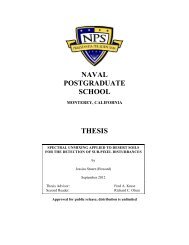October 2000 Newsletter - Naval Postgraduate School
October 2000 Newsletter - Naval Postgraduate School
October 2000 Newsletter - Naval Postgraduate School
Create successful ePaper yourself
Turn your PDF publications into a flip-book with our unique Google optimized e-Paper software.
RESEARCH AND EDUCATION<br />
WEAPONEERING: FROM A JTCG/ME PERSPECTIVE, continued from page 13<br />
over the last 10 months a set of notes to hand<br />
out to the students. If the necessary clearances<br />
can be obtained, these notes will form the basis<br />
of the first textbook in weaponeering. The<br />
course is unique, certainly in the U.S. and<br />
maybe outside. Considerable interest in the<br />
material has been expressed by many of the<br />
people who are collegues in the JTCG community,<br />
who like Driels would like to understand<br />
“the bigger picture” as well as their own area of<br />
speciality. The course may be offered as a short<br />
course outside NPS in the future.<br />
Working in this more operationally oriented<br />
environment is very different from that associated<br />
with a more traditional academic research<br />
program. The latter is usually associated with<br />
producing as an end product peer reviewed<br />
journal papers, conference papers, reviews of<br />
other peoples papers and so on. In the JTCG,<br />
there is an Operational Users Working Group<br />
(OUWG) which meets twice a year at bases all<br />
over the U.S. At these meetings, the audience is<br />
comprised of around 50 aviators, planners,<br />
targeteers, military and civilian users of JAWS. The researchers<br />
present their accomplisments over the last six months and<br />
outline their plans for the next six. The aviators are not slow<br />
in coming forward to say what they think of your work after<br />
all, they may be using it in the next month to go into harms<br />
ME4300 WEAPONEERING – COURSE SYLLABUS, continued from page 13<br />
9.3 Fractional overlap of target by damage function<br />
9.4 Target smaller than the damage function<br />
9.5 Spreadsheet implementation<br />
10. Stick deliveries<br />
10.1 Introduction<br />
10.2 Weapon release conditions<br />
10.3 Calculating stick length<br />
10.4 Ballistic dispersion for sticks<br />
10.5 Pattern dimensions<br />
10.6 Weapon sparsity and overlap in the pattern<br />
10.7 Computing SSPDs<br />
10.8 Spreadsheet implementation<br />
11. Projectiles<br />
11.1 Guns<br />
11.2 Rockets<br />
11.3 Spreadsheet implementation<br />
Figure 4. JTCG Operational User Working Group Meeting at Dyess<br />
AFB.<br />
way. This gives an immediacy that was absent from more<br />
traditional programs, and an overiding motive to “get it right<br />
the first time.” Debugging one’s code by losing a few FA-18s<br />
is expensive! Participants from a recent meeting of the<br />
12. Cluster munitions<br />
12.1 Releasable dispensers<br />
12.2 Time and altitude fuzing<br />
12.3 Trajectory computations for cluster munitions<br />
12.4 Wind corrected munitions dispenser (WCMDs)<br />
12.5 Spreadsheet implementation<br />
13. Methods for particular types of target<br />
13.1 Buildings<br />
13.2 Bridges<br />
13.3 Linear targets (runways, railroad tracks etc.)<br />
13.4 Hardened targets<br />
13.5 Ships<br />
--continued on page 48<br />
14. Methods for particular types of weapon<br />
14.1 GPS guided munitions<br />
14.2 Conventional air launched cruise missiles (CALCM)<br />
NPS Research page 47<br />
<strong>October</strong> <strong>2000</strong>
















